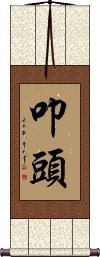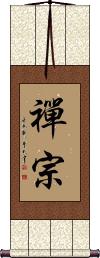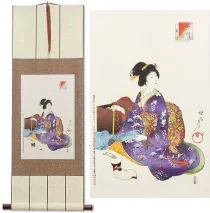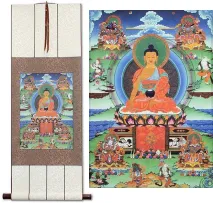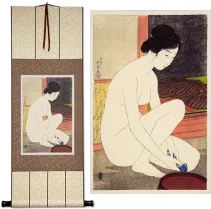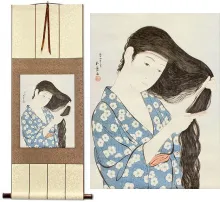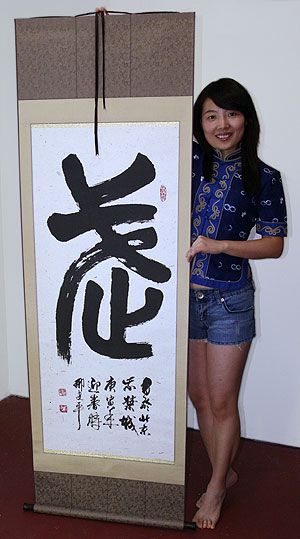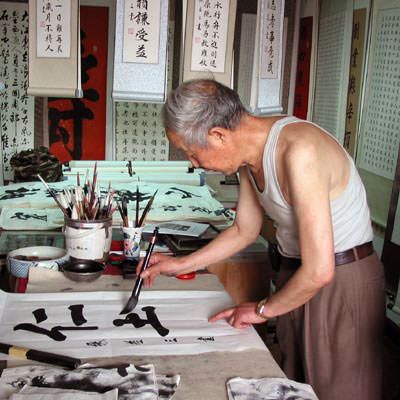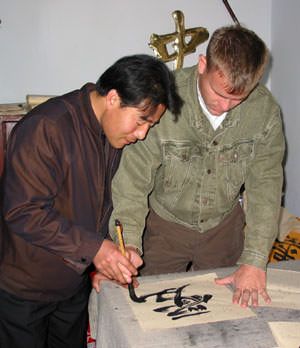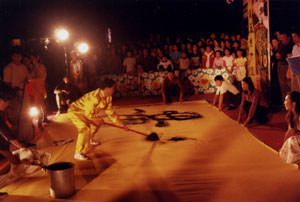Many custom options...
And formats...

Ritual in Chinese / Japanese...
Buy a Ritual calligraphy wall scroll here!
Personalize your custom “Ritual” project by clicking the button next to your favorite “Ritual” title below...
Taotie
In ancient China, 饕餮 was a ferocious mythological animal and the fifth son of the dragon king.
饕餮 can also refer to a zoomorphic mask motif found on Shang and Zhou ritual bronzes.
As an adjective, this can mean gluttonous, sumptuous (banquet), covetousness, greed, avarice, or intense desire.
Easter
復活節 is the Chinese and old Korean way to write Easter.
Easter is not a well-known holiday in China, but Chinese Christians tend to follow the American tradition of the Easter egg ritual, etc. Non-Christians may think it's a celebration of rabbits that can lay eggs.
South Korea has a higher percentage of Christians than any other Asian country, so they celebrate Easter with plenty of enthusiasm.
Duty to Defend and Protect Country
守土有責 is a Chinese proverb that expresses one's duty to defend the country.
守 means to guard, defend, keep watch, abide by the law, and/or observe (rules or ritual).
土 means land, earth, or soil.
有 is a possessive modifier in effect meaning “is a.”
責 means duty or responsibility.
So you get a literal translation of “Protecting [the] land is [a] duty/responsibility.”
Kowtow - The deepest bow
叩頭 is the term that seems to be known worldwide as kowtow.
In Japanese and Chinese, it simply means a deep bow, especially one so low that one's head touches the ground in submission. However, in western culture, it has sometimes come to mean “giving in” or “surrendering to someone else's will.” Sometimes even said of a person who stoops to flattery at the expense of their dignity.
I don't know if you would really want this on a wall scroll, but enough people have searched for this term on our website that I guess it was time to add it. It just feels strange to see such a word on a wall scroll, so please order with caution. 叩頭 is antiquated in both Japanese and Chinese. The act is seldom done anymore and is seen as an ancient ritual.
Zen Buddhism
禪宗 is one way to title “Zen Buddhism.” Because the original pronunciation of Zen in Chinese is Chan, you'll also see this expressed as Chan Buddhism.
From the Buddhist Dictionary:
The Chan, meditative or intuitional, sect is usually said to have been established in China by Bodhidharma, the twenty-eighth patriarch, who brought the tradition of the Buddha-mind from India. This sect, believing in direct enlightenment, disregarded ritual and sūtras and depended upon the inner light and personal influence for the propagation of its tenets, founding itself on the esoteric tradition supposed to have been imparted to Kāśyapa by the Buddha, who indicated his meaning by plucking a flower without further explanation. Kāśyapa smiled in apprehension and is supposed to have passed on this mystic method to the patriarchs. The successor of Bodhidharma was 慧可 Huike, and he was succeeded by 僧璨 Sengcan, 道信 Daoxin, 弘忍 Hongren, 慧能 Huineng, and 神秀 Shenxiu, the sect dividing under the two latter into the southern and northern schools: the southern school became prominent, producing 南嶽 Nanyue and 靑原 Qingyuan, the former succeeded by 馬祖 Mazu, the latter by 石頭 Shitou. From Mazu's school arose the five later schools.
This in-stock artwork might be what you are looking for, and ships right away...
Gallery Price: $108.00
Your Price: $59.88
Gallery Price: $60.00
Your Price: $36.88
Gallery Price: $60.00
Your Price: $36.88
Gallery Price: $108.00
Your Price: $59.88
Gallery Price: $108.00
Your Price: $59.88
Not the results for ritual that you were looking for?
Below are some entries from our dictionary that may match your ritual search...
| Characters If shown, 2nd row is Simp. Chinese |
Pronunciation Romanization |
Simple Dictionary Definition |
礼 see styles |
rei / re れい |
More info & calligraphy: Respect |
禮 礼 see styles |
lǐ li3 li rai らい |
More info & calligraphy: Respect(personal name) Rai Worship, offerings, rites; ritual, ceremonial, decorum, courtesy, etiquette. |
禪宗 禅宗 see styles |
chán zōng chan2 zong1 ch`an tsung chan tsung Zenshū |
More info & calligraphy: Zen BuddhismThe Chan, meditative or intuitional, sect usually said to have been established in China by Bodhidharma, v. 達, the twenty-eighth patriarch, who brought the tradition of the Buddha-mind from India. Cf. 楞 13 Laṅkāvatāra sūtra. This sect, believing in direct enlightenment, disregarded ritual and sūtras and depended upon the inner light and personal influence for the propagation of its tenets, founding itself on the esoteric tradition supposed to have been imparted to Kāśyapa by the Buddha, who indicated his meaning by plucking a flower without further explanation. Kāśyapa smiled in apprehension and is supposed to have passed on this mystic method to the patriarchs. The successor of Bodhidharma was 慧可 Huike, and he was succeeded by 僧璨 Sengcan; 道信 Daoxin; 弘忍 Hongren; 慧能 Huineng, and 神秀 Shenxiu, the sect dividing under the two latter into the southern and northern schools: the southern school became prominent, producing 南嶽 Nanyue and 靑原 Qingyuan, the former succeeded by 馬祖 Mazu, the latter by 石頭 Shitou. From Mazu's school arose the five later schools, v. 禪門. |
饕餮 see styles |
tāo tiè tao1 tie4 t`ao t`ieh tao tieh toutetsu / totetsu とうてつ |
More info & calligraphy: Taotie(1) (hist) taotie (Chinese mythological creature commonly represented as a motif on ritual bronzes from the Shang and Zhou dynasties); (2) (archaism) covetousness; greed; avarice intense desire |
唵 see styles |
ǎn an3 an on おん |
(interjection) oh!; (dialect) to stuff something in one's mouth; (used in buddhist transliterations) om (interjection) (See オーム) om (ritual chant in Hinduism, etc.); aum oṃ; auṃ; 'a word of solemn affirmation and respectful assent (sometimes translated by yes, verily, so be it, and in this sense compared with Amen). 'M. W. It is 'the mystic name for the Hindu triad', and has other significations. It was adopted by Buddhists, especially by the Tantric school, as a mystic spell, and as an object of meditation. It forms the first syllable of certain mystical combinations, e. g. 唵?呢叭 061971 吽 oṃ maṇi padme huṃ, which is a formula of the Lamaistic branch, said to be a prayer to Padmapani; each of the six syllables having its own mystic power of salvation from the lower paths of transmigration, etc.; the formula is used in sorcery, auguries, etc.; other forms of it are 唵?呢鉢頭迷吽; 唵麽抳鉢訥銘吽. |
塵 尘 see styles |
chén chen2 ch`en chen chiri ちり |
dust; dirt; earth (1) dust; (2) trash; garbage; rubbish; dirt; (3) (usu. as 塵ほども...ない) negligible amount; tiny bit; (4) hustle and bustle (of life); worldly cares; impurities of the world; (5) (abbreviation) {sumo} (See 塵手水) ritual gestures indicating that a fight will be clean guṇa, in Sanskrit inter alia means 'a secondary element', 'a quality', 'an attribute of the five elements', e.g. 'ether has śabda or sound for its guṇa and the ear for its organ'. In Chinese it means 'dust, small particles; molecules, atoms, exhalations'. It may be intp. as an atom, or matter, which is considered as defilement; or as an active, conditioned principle in nature, minute, subtle, and generally speaking defiling to pure mind; worldly, earthly, the world. The six guṇas or sensation-data are those of sight, sound, smell, taste, touch, and thought. |
守 see styles |
shǒu shou3 shou kami かみ |
to guard; to defend; to keep watch; to abide by the law; to observe (rules or ritual); nearby; adjoining (hist) (See 国司,長官・かみ) director (of the provincial governors under the ritsuryō system); (personal name) Morinori Keep, guard, observe. |
式 see styles |
shì shi4 shih shiki しき |
type; form; pattern; style (n,n-suf) (1) way; style; fashion; method; system; form; type; (2) ceremony; rite; ritual; celebration; (3) wedding (ceremony); (4) equation; formula; expression; (5) (hist) (See 律令) enforcement regulations (of the ritsuryō legal codes); (given name) Shoku Style, shape, fashion, kind. |
槱 see styles |
yǒu you3 yu |
ritual bonfire |
祓 see styles |
fú fu2 fu harae はらえ harai はらい |
to cleanse; to remove evil; ritual for seeking good fortune and avoiding disaster purification; exorcism |
禊 see styles |
xì xi4 hsi misogi みそぎ |
semiannual ceremony of purification (noun/participle) {Shinto} purification ceremony (performed with water); ritual purification; ablutions; (female given name) Misogi |
禡 祃 see styles |
mà ma4 ma |
(arch.) religious ritual on setting out for war |
齋 斋 see styles |
zhāi zhai1 chai hitoshi ひとし |
to fast or abstain from meat, wine etc; vegetarian diet; study room; building; to give alms (to a monk) (surname) Hitoshi To reverence: abstinence; to purify as by fasting, or abstaining, e.g. from flesh food; religious or abstinential duties, or times; upavasatha (uposatha), a fast; the ritual period for food, i.e. before noon; a room for meditation, a study, a building, etc., devoted to abstinence, chastity, or the Buddhist religion; mourning (for parents). |
お礼 see styles |
orei / ore おれい |
(1) (polite language) thanks; gratitude; (2) (polite language) manners; etiquette; (3) (polite language) bow; (4) (polite language) reward; gift; (5) (polite language) ceremony; ritual |
九字 see styles |
jiǔ zì jiu3 zi4 chiu tzu kuji くじ |
{Buddh} (See 臨兵闘者皆陣裂在前) nine-character charm chanted with ritual gestures to ward off evil (esp. by mountain ascetics and adherents of Esoteric Buddhism) The nine magical characters 臨兵鬪者皆陳列在前 implying that the armed forces are arrayed against the powers of evil. After reciting these words, four vertical and five horizontal lines, forming a grid, are drawn in the air to show that the forces are arrayed. It was used among Taoists and soldiers, and is still used in Japan, especially when going into the mountains. |
仏具 see styles |
butsugu; bugu ぶつぐ; ぶぐ |
Buddhist ritual implements (esp. altar fittings); (surname) Butsugu |
仏式 see styles |
busshiki ぶっしき |
Buddhist ritual |
仕切 see styles |
shikiri しきり |
(irregular okurigana usage) (1) partition; division; boundary; compartment; (2) settlement of accounts; (3) (sumo) preliminary warm-up ritual; toeing the mark; (4) directing; controlling; managing; taking responsibility for; (surname) Shikiri |
修法 see styles |
xiū fǎ xiu1 fa3 hsiu fa shuhou; zuhou(ok); suhou(ok) / shuho; zuho(ok); suho(ok) しゅほう; ずほう(ok); すほう(ok) |
to amend a law {Buddh} prayer and austerities [esoteric] ritual |
倭鞍 see styles |
wagura わぐら yamatogura やまとぐら |
Japanese-style ritual saddle |
儀典 仪典 see styles |
yí diǎn yi2 dian3 i tien giten ぎてん |
ceremony ceremony; rite; ritual; service; (given name) Yoshinori |
儀式 仪式 see styles |
yí shì yi2 shi4 i shih gishiki ぎしき |
ceremony ceremony; rite; ritual; service; (place-name) Gishiki 儀軌 Mode, style, manner. |
儀礼 see styles |
girei / gire ぎれい |
(1) courtesy; etiquette; formality; protocol; (2) (religious) observance; ritual; rite; (given name) Girei |
先腹 see styles |
sakibara; senpuku; senbara(ok) さきばら; せんぷく; せんばら(ok) |
(1) (See 後腹・あとばら・3) child from an earlier wife; (2) (さきばら only) (See 追い腹) preceding one's master into death by committing ritual suicide (seppuku) |
冠禮 冠礼 see styles |
guàn lǐ guan4 li3 kuan li |
the capping ceremony, a Confucian coming of age ceremony for males dating from pre-Qin times, performed when a boy reaches the age of 20, involving the ritual placing of caps on the head of the young man |
切腹 see styles |
qiē fù qie1 fu4 ch`ieh fu chieh fu seppuku せっぷく |
harakiri (formal Japanese: seppuku), a samurai's suicide by disemboweling (noun/participle) (1) seppuku; harakiri; ritual suicide by disembowelment; (noun/participle) (2) (hist) seppuku as a death penalty (where the convict is decapitated by a second as they make the motions to disembowel themself; Edo period) |
号令 see styles |
gourei / gore ごうれい |
(n,vs,vt,vi) (1) order (esp. to a number of people); command; (n,vs,vt,vi) (2) ritual of bowing at start and end of school class |
呪法 see styles |
juhou / juho じゅほう |
(1) {Buddh} esoteric Buddhist ritual where incantations are chanted; (2) magic |
和鞍 see styles |
wakura わくら |
Japanese-style ritual saddle; (surname) Wakura |
唐鞍 see styles |
karakura; karagura からくら; からぐら |
(See 大和鞍) Chinese-style ritual saddle |
Click here for more ritual results from our dictionary
The following table may be helpful for those studying Chinese or Japanese...
| Title | Characters | Romaji (Romanized Japanese) | Various forms of Romanized Chinese | |
| Taotie | 饕餮 | tou tetsu / toutetsu / to tetsu | tāo tiè / tao1 tie4 / tao tie / taotie | t`ao t`ieh / taotieh / tao tieh |
| Easter | 復活節 复活节 | fù huó jié fu4 huo2 jie2 fu huo jie fuhuojie | fu huo chieh fuhuochieh |
|
| Duty to Defend and Protect Country | 守土有責 守土有责 | shǒu tǔ yǒu zé shou3 tu3 you3 ze2 shou tu you ze shoutuyouze | shou t`u yu tse shoutuyutse shou tu yu tse |
|
| Kowtow - The deepest bow | 叩頭 叩头 | koutou / koto | kòu tóu / kou4 tou2 / kou tou / koutou | k`ou t`ou / koutou / kou tou |
| Zen Buddhism | 禪宗 禅宗 | zen shuu / zenshuu / zen shu | chán zōng chan2 zong1 chan zong chanzong | ch`an tsung chantsung chan tsung |
| In some entries above you will see that characters have different versions above and below a line. In these cases, the characters above the line are Traditional Chinese, while the ones below are Simplified Chinese. | ||||
Successful Chinese Character and Japanese Kanji calligraphy searches within the last few hours...



